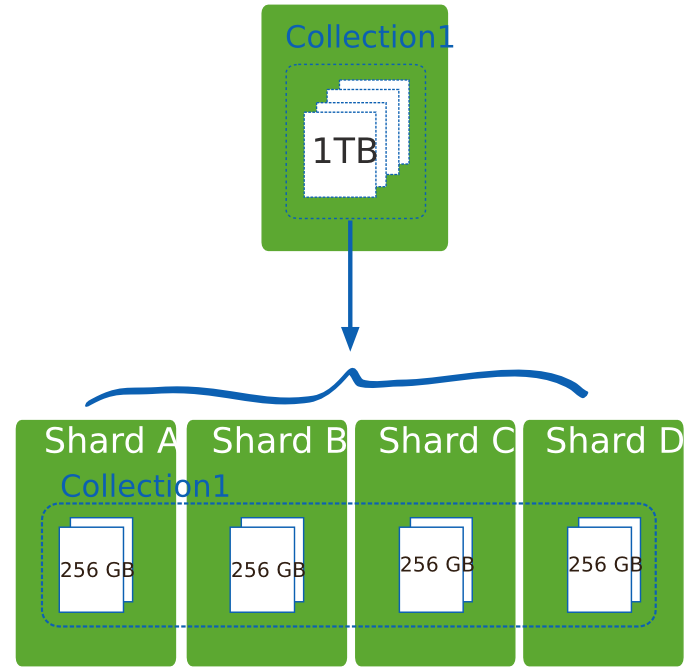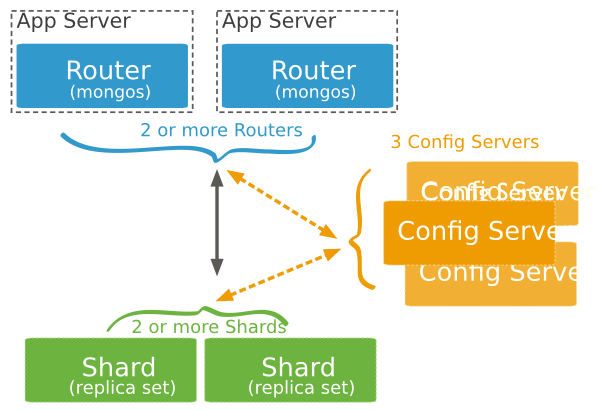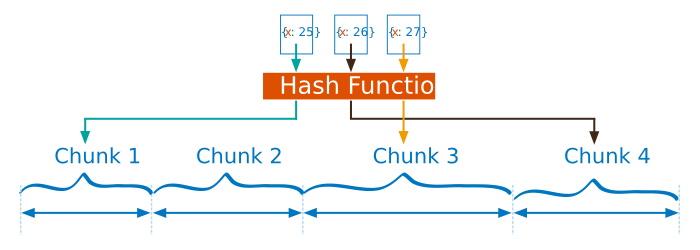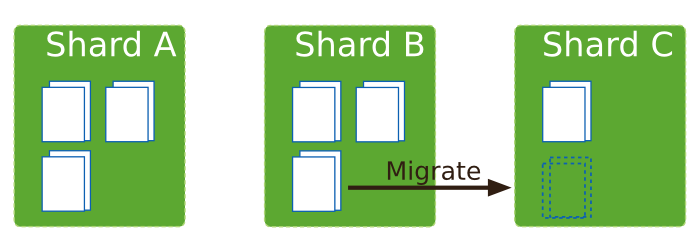- 分片 >
- 分片介绍
分片介绍¶
分片是使用多个机器存储数据的方法,MongoDB使用分片以支持巨大的数据存储量与对数据操作.
分片的目的¶
高数据量和吞吐量的数据库应用会对单机的性能造成较大压力,大的查询量会将单机的CPU耗尽,大的数据量对单机的存储压力较大,最终会耗尽系统的内存而将压力转移到磁盘IO上.
为了解决这些问题,有两个基本的方法: 纵向扩展 和 分片 .
Vertical scaling adds more CPU and storage resources to increase capacity. Scaling by adding capacity has limitations: high performance systems with large numbers of CPUs and large amount of RAM are disproportionately more expensive than smaller systems. Additionally, cloud-based providers may only allow users to provision smaller instances. As a result there is a practical maximum capability for vertical scaling.
Sharding, or horizontal scaling, by contrast, divides the data set and distributes the data over multiple servers, or shards. Each shard is an independent database, and collectively, the shards make up a single logical database.

Diagram of a large collection with data distributed across 4 shards.
分片为应对高吞吐量与大数据量提供了方法.
使用分片减少了每个分片需要处理的请求数,因此,通过 水平扩展 ,集群可以提高自己的存储容量和吞吐量.
举例来说,当插入一条数据时,应用只需要访问存储这条数据的分片.
使用分片减少了每个分片存储的数据.
举例来说,如果一个数据库有1TB数据,并有4个分片,则每个分片只需要存储256GB数据,如果数据库有40个分片,则每个分片只需要存储25GB数据.
MongoDB的分片¶
MongoDB通过配置 集群 支持分片.

Diagram of a sample sharded cluster for production purposes. Contains exactly 3 config servers, 2 or more mongos query routers, and at least 2 shards. The shards are replica sets.
集群拥有以下组件: 分片, 分发路由,:term:配置服务器 <config server>.
Shards store the data. To provide high availability and data consistency, in a production sharded cluster, each shard is a replica set [1]. For more information on replica sets, see Replica Sets.
Query Routers, or mongos instances, interface with client applications and direct operations to the appropriate shard or shards. The query router processes and targets operations to shards and then returns results to the clients. A sharded cluster can contain more than one query router to divide the client request load. A client sends requests to one query router. Most sharded cluster have many query routers.
Config servers store the cluster’s metadata. This data contains a mapping of the cluster’s data set to the shards. The query router uses this metadata to target operations to specific shards. Production sharded clusters have exactly 3 config servers.
| [1] | 在测试与开发环境下,每个 分片 可以是单独的 mongod 而不用必须是复制集.在生产环境中 必须 部署3台配置服务器. |
数据分区¶
MongoDB中数据的分片是以集合为基本单位的,集合中的数据通过 片键 被分成多部分.
片键¶
对集合进行分片时,你需要选择一个 片键 , shard key 是每条记录都必须包含的,且建立了索引的单个字段或复合字段,MongoDB按照片键将数据划分到不同的 数据块 中,并将 数据块 均衡地分布到所有分片中.为了按照片键划分数据块,MongoDB使用 基于范围的分片方式 或者 基于哈希的分片方式 ,参见 片键 获得更多信息.
以范围为基础的分片¶
对于 基于范围的分片 ,MongoDB按照片键的范围把数据分成不同部分.假设有一个数字的片键:想象一个从负无穷到正无穷的直线,每一个片键的值都在直线上画了一个点.MongoDB把这条直线划分为更短的不重叠的片段,并称之为 数据块 ,每个数据块包含了片键在一定范围内的数据.
在使用片键做范围划分的系统中,拥有”相近”片键的文档很可能存储在同一个数据块中,因此也会存储在同一个分片中.

Diagram of the shard key value space segmented into smaller ranges or chunks.
基于哈希的分片¶
对于 基于哈希的分片 ,MongoDB计算一个字段的哈希值,并用这个哈希值来创建数据块.
在使用基于哈希分片的系统中,拥有”相近”片键的文档 很可能不会 存储在同一个数据块中,因此数据的分离性更好一些.

Diagram of the hashed based segmentation.
基于范围的分片方式与基于哈希的分片方式性能对比¶
基于范围的分片方式提供了更高效的范围查询,给定一个片键的范围,分发路由可以很简单地确定哪个数据块存储了请求需要的数据,并将请求转发到相应的分片中.
不过,基于范围的分片会导致数据在不同分片上的不均衡,有时候,带来的消极作用会大于查询性能的积极作用.比如,如果片键所在的字段是线性增长的,一定时间内的所有请求都会落到某个固定的数据块中,最终导致分布在同一个分片中.在这种情况下,一小部分分片承载了集群大部分的数据,系统并不能很好地进行扩展.
与此相比,基于哈希的分片方式以范围查询性能的损失为代价,保证了集群中数据的均衡.哈希值的随机性使数据随机分布在每个数据块中,因此也随机分布在不同分片中.但是也正由于随机性,一个范围查询很难确定应该请求哪些分片,通常为了返回需要的结果,需要请求所有分片.
数据均衡的维护¶
新数据的加入或者新分片的加入可能会导致集群中数据的不均衡,即表现为有些分片保存的数据块数目显著地大于其他分片保存的数据块数.
MongoBD使用两个过程维护集群中数据的均衡:分裂和均衡器.
分裂¶
分裂是防止某个数据块过大而进行的一个后台任务.当一个数据块的大小超过 :ref:`设定的数据块大小 <sharding-chunk-size>`时,MongoDB会将其一分为二,插入与更新触发分裂过程.分裂改变了元信息,但是效率很高.进行分裂时,MongoDB 不会 迁移任何数据,对集群性能也没有影响.

Diagram of a shard with a chunk that exceeds the default chunk size of 64 MB and triggers a split of the chunk into two chunks.
均衡¶
The balancer is a background process that manages chunk migrations. The balancer runs in all of the query routers in a cluster.
当集群中数据的不均衡发生时,均衡器会将数据块从数据块数目最多的分片迁移到数据块最少的分片上,举例来讲:如果集合 users 在 分片1 上有100个数据块,在 分片2 上有50个数据块,均衡器会将数据块从 分片1 一直向 分片2 迁移,一直到数据均衡为止.
分片管理在后台管理从 源分片 到 目标分片 的 数据块迁移 ,在迁移过程中, 目标分片 首先会接收源分片在迁移数据块上的所有数据,之后,目标分片应用在上一迁移步骤之间发生在源分片上的迁移数据块的更改,最后,存储在 配置服务器 上的元信息被更新.
如果迁移中发生错误,源分片上的数据不会被修改,迁移会停止.在迁移成功 结束 之后MongoDB才会在源分片上将数据删除.

Diagram of a collection distributed across three shards. For this collection, the difference in the number of chunks between the shards reaches the migration thresholds (in this case, 2) and triggers migration.
在集群中增加或者删除分片¶
在集群中增加分片时,由于新的分片上并没有数据块,会造成数据的不均衡.此时MongoDB会立即开始向新分片迁移数据,集群达到数据均衡的状态需要花费一些时间.
当删除一个分片时,均衡器需要将被删除的分片上的数据全部迁移到其他分片上,在全部迁移结束且元信息更新完毕之后,你可以安全地将这个分片移除.
